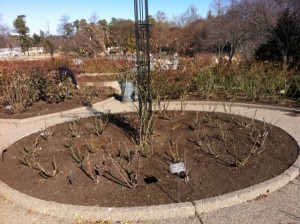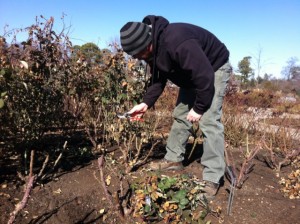There's A Lot of Pruning Going On in the Rose Garden!
by Brenda Brown, PR & Marketing Intern, Lewis Ginter Botanical Garden
Visit the Garden this week and you will most likely see rose beds that are being prepared for this spring. You might be wondering why roses are being pruned so early and you may be thinking that fluctuating weather should be a deterrent for pruning roses right now. There are a few things you may not know about the Rose Garden at Lewis Ginter Botanical Garden — like there are 2,000 roses that need to be pruned by blooming time.
I walked out to one of the rose beds and found Jay Austin, the rose gardener, clipping away with his shears. I asked Jay about why he was pruning and what methods he used. He says that typically, you want to start pruning when the buds begin to swell (typically early march, but depends on weather.) He added that here at the Garden we can’t wait that long, because there are so many roses! No worries though, because he says that if we get another frost he’ll just cut back the wood of the roses taking off any damaged places. Jay has a method of pruning which allows air flow and sun to reach through and around the middle of each rose. Lucky for you, he patiently showed me exactly how to look for new wood and how to get rid of the old, and I’m going to share it with you.
Jay says when you cut back roses, it helps to remember that the more air and light they can get the happier they will be. Happy roses mean healthy, big and showy blooms. Also, a good pruning encourages strong new growth and thicker stems toward the top of the plant. He encourages pruners not to be timid when pruning back. One should look for any wood that is obviously old or damaged and cut it out. Also look for other opportunities to cut, opening up the mid-section of the plant for sun and air flow. This aggressive pruning helps the plant to send up new, stable, thick and healthy wood.
Jay’s goal for pruning is to have all 2,000 roses dressed and ready in time for Orchids Galore! on March 12 and is sure to bring scores of visitors. I asked Jay about the different roses at the Garden. Jay explained to me that Lewis Ginter Botanical Garden’s goal when planning the Rose Garden was to have the best type of roses visitors could enjoy during spring, summer and fall. The criteria for roses in the Garden was to include disease resistant, and re-bloomers (fall bloomers) with showy and fragrant flowers. The Garden wanted roses that have all the benefits of disease resistance but don’t sacrifice the fragrance. David Austin (no relation to Jay Austin), who sells English Roses, has helped Lewis Ginter Botanical Garden find some of those. Other featured roses are classics that happen to be extremely fragrant hybrids, Chrysler Imperial and Mr. Lincoln, are examples here in the Garden.
The unique design of the Rose Garden greets the visitor with meandering 6-foot-wide walkways, allowing the visitor to get close to the blooming roses. The intentional design of color schemes in the rose beds adds unique color-blending aspects. The central oval lawn is planted in whites and creams, with pinks, purples and reds building gradually in intensity to the right side of the bed and yellows, apricots and oranges create a different color proliferation on the left side of the central garden. In addition to the fragrant and beautiful display, the garden teaches about rose breeding and culture. The rose gardens are the longest-blooming flowering plants in the Garden and will provide a long season of interest and color long after the first blooming in early May.
I asked Jay what they next process is after pruning is complete to prepare the roses for blooming season. He explained that he will feed the roses an organic slow-release fertilizer meant only to prepare the roses and the soil for more intentional fertilizing that will encourage growth and blooming when the time is right.
The FYI’s of the Rose Garden also provides great information about rose varieties and how to plant, grow and maintain roses (you can also pick it up at the front desk of the Garden’s Robins Visitor Center.) Next time you visit, don’t miss the beautifully-framed views across the lake. From this vantage point you can also see an under-planting of April flowering azaleas framing the view to the lake and bridge throughout the growing season. Thousands of blooming roses are pruned and now wait to wow you with their show-stopping performance on nature’s stage right here at Lewis Ginter Botanical Garden.
Note: If you love roses, you may want to save the date for the Richmond Rose Society Show at Lewis Ginter Botanical Garden on May 28- 29.



